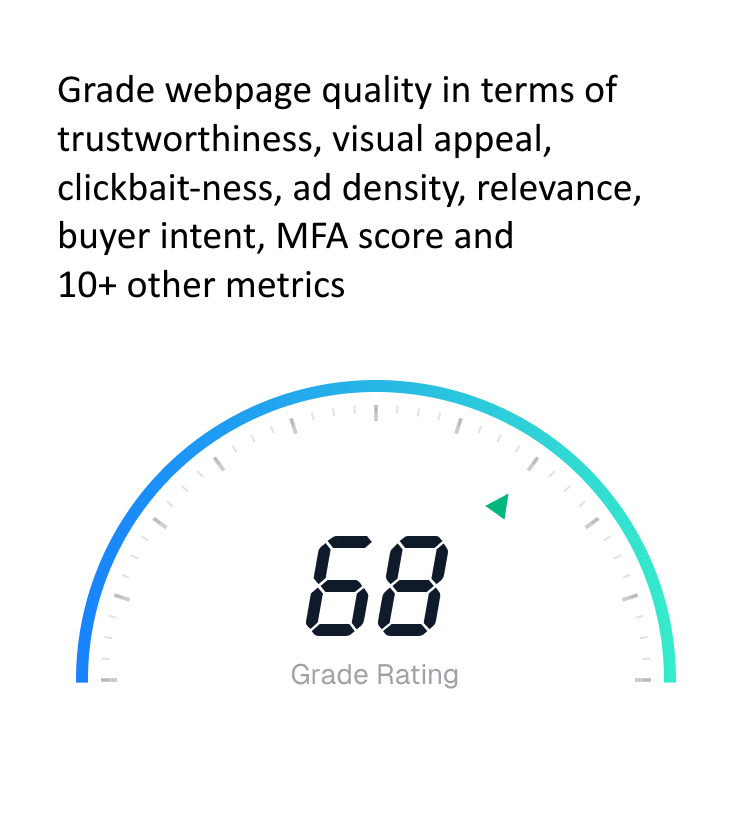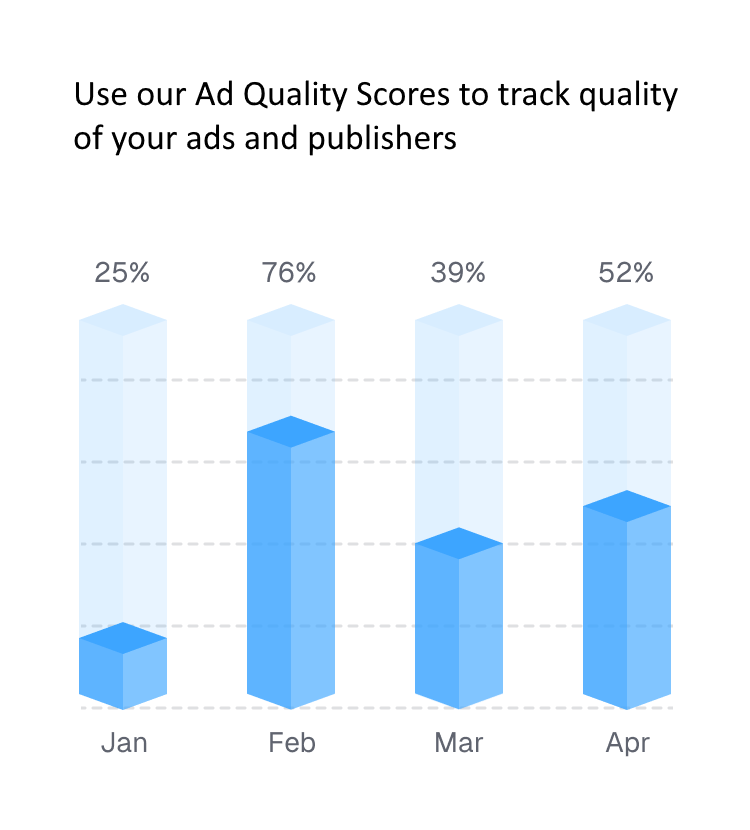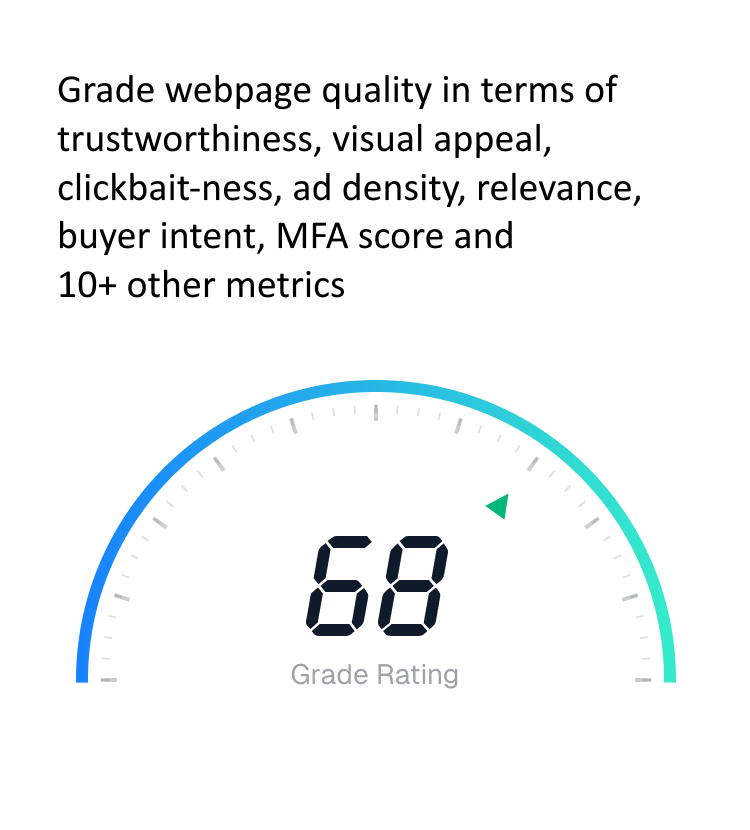Comprehensive quality assessment with 20+ metrics. Evaluate trustworthiness, detect MFA sites, measure engagement quality, and ensure brand safety with our advanced quality scoring system.
Try Quality CheckerKnowing what category a website falls into is important, but understanding the quality of that website is equally critical for making informed business decisions. Two websites might both be categorized as "Technology News," but one could be a reputable publication with original reporting while the other is a low-quality site filled with clickbait headlines and recycled content. Traditional categorization alone cannot distinguish between these scenarios.

Our Website Quality Scores feature addresses this gap by providing a comprehensive framework for evaluating website and content quality across multiple dimensions. We track over 20 distinct quality metrics, each designed to capture specific aspects of website quality, content value, user experience, and business legitimacy. Together, these metrics provide a holistic quality assessment that empowers better decision-making across advertising, content curation, cybersecurity, and business intelligence applications.
Quality scoring has become increasingly important in the digital ecosystem. Advertisers need to ensure their ads appear on high-quality placements that enhance rather than damage their brand. Content curators must distinguish valuable content from low-quality spam. Cybersecurity teams need to identify suspicious or malicious sites. Business intelligence platforms require quality signals to assess the legitimacy and reliability of companies and websites they analyze.
Our quality scoring system evaluates websites across multiple dimensions, each capturing different aspects of quality. These dimensions work together to provide a complete quality picture:
Evaluates overall site credibility based on domain age, SSL certificates, contact information, privacy policies, and authoritative signals.
Assesses writing quality, originality, depth of coverage, factual accuracy indicators, and editorial standards.
Measures design quality, layout professionalism, color scheme coherence, and overall aesthetic presentation.
Analyzes site navigation, mobile responsiveness, page load speed, accessibility features, and ease of use.
Evaluates content depth, reading level appropriateness, multimedia integration, and interaction opportunities.
Identifies sensationalized headlines, emotional manipulation, curiosity gap tactics, and misleading content promises.
Detects Made-For-Advertising sites created solely for ad revenue with thin content and excessive advertising.
Identifies misleading claims, fake reviews, impersonation attempts, and deceptive business practices.
Assesses reputation risk, controversial content, sensitive topics, and potential brand association hazards.
Measures commercial intent signals, purchase readiness indicators, and conversion potential.
Evaluates update frequency, content recency, maintenance indicators, and timeliness of information.
Identifies expertise indicators, credential displays, author qualifications, and authoritative citations.
Assesses code quality, web standards compliance, security implementations, and technical best practices.
Measures ad-to-content ratio, ad placement intrusiveness, and overall advertising saturation.
Analyzes social media presence, social sharing indicators, community engagement, and social validation signals.
Evaluates comprehensive coverage, detail level, supporting evidence, and information completeness.
Measures emotional tone appropriateness, balanced presentation, objectivity, and sentiment consistency.
Detects spam signals, keyword stuffing, link farms, automated content, and other spam characteristics.
Assesses mobile-specific design, responsive layout, touch-friendly interfaces, and mobile performance.
Evaluates compliance with WCAG standards, screen reader compatibility, and inclusive design practices.
Trustworthiness represents the foundation of quality assessment. A site might have beautiful design and engaging content, but if users cannot trust the information or the business behind it, quality is fundamentally compromised. Our trustworthiness scoring examines multiple factors that contribute to or detract from site credibility.
Domain age and history provide important trust signals. Established domains with long histories generally prove more trustworthy than newly registered domains. We analyze domain registration dates, ownership history, and historical content patterns. Frequent ownership changes or recent registration combined with aggressive monetization suggest lower trustworthiness.
Security indicators like SSL certificates, secure payment implementations, and privacy policy presence signal professionalism and user protection. Sites lacking these basic security measures score lower on trustworthiness. We also check for security seal badges, trust marks, and third-party certifications that legitimate businesses often display.

Contact information transparency matters significantly. Trustworthy sites clearly display contact methods, physical addresses, company information, and customer service details. Sites hiding their identity, using only web forms for contact, or providing no contact information receive lower trust scores.
Authority signals complement trustworthiness by indicating expertise and credibility in the site's subject area. We look for author credentials, expert bylines, editorial standards disclosure, fact-checking processes, source citations, and links to authoritative references. Sites demonstrating clear expertise and editorial rigor score higher in authority metrics.
Content quality evaluation examines the actual value and professionalism of website content. Our systems analyze writing quality using natural language processing to assess grammar, spelling, sentence structure, and overall writing sophistication. Well-written, professionally edited content receives higher scores than error-filled, poorly constructed text.
Originality detection identifies duplicate or plagiarized content. Sites that aggregate content from other sources without adding value score lower than those producing original reporting, analysis, or creative work. We compare content against large corpora of web content to detect substantial similarity to existing materials.
Content depth measures how thoroughly topics are covered. Superficial content that barely scratches the surface of topics scores lower than comprehensive coverage providing detailed information, multiple perspectives, and thorough exploration of subjects. We analyze content length, topic coverage breadth, supporting details presence, and information completeness.
Factual accuracy indicators, while not performing full fact-checking, identify patterns associated with reliable versus unreliable information. These include citation practices, primary source usage, balanced perspective presentation, acknowledgment of uncertainty where appropriate, and avoidance of absolute claims without supporting evidence.
Made-For-Advertising (MFA) sites represent a significant concern for advertisers. These sites are created primarily or exclusively to generate advertising revenue, featuring thin content, excessive ads, and little genuine user value. MFA sites waste advertising budgets, damage brand perception, and provide minimal campaign value.
Our MFA detection system identifies these sites using multiple signals. Ad density analysis measures the ratio of advertising to actual content. Sites where ads dominate the user experience receive high MFA scores. We count ad units, measure ad space versus content space, and evaluate ad placement intrusiveness.
Content quality indicators help identify MFA sites. These sites typically feature thin content with minimal substance, often using content spinning or light rewriting of articles from other sources. Short articles, lack of original insights, heavy use of generic stock images, and minimal content depth all indicate potential MFA characteristics.
User experience patterns on MFA sites differ from legitimate publishers. MFA sites often employ aggressive ad placements, interstitials, pop-ups, auto-playing video ads, and other intrusive advertising formats designed to maximize ad impressions regardless of user experience. We detect these patterns as strong MFA indicators.
Site structure analysis reveals MFA characteristics. These sites often have shallow site structures, limited navigation, few internal pages, and content organized primarily to maximize ad exposure rather than user navigation. Legitimate publishers invest in site architecture, comprehensive navigation, and user-centered design.
For advertisers, MFA detection provides crucial protection against wasted ad spend. By filtering out MFA sites, advertisers ensure their budgets reach real audiences on quality placements rather than artificial traffic and low-value inventory. Our MFA scores allow advertisers to set thresholds appropriate to their quality requirements and budget constraints.
Clickbait content uses sensationalized headlines and manipulative tactics to generate clicks without delivering on content promises. While not necessarily malicious, clickbait damages user experience and represents low-quality content that brands should avoid associating with.
Our clickbait detection analyzes headline characteristics, including emotional language intensity, curiosity gap exploitation ("You won't believe what happened next"), number usage in headlines, superlatives and exaggeration, and disconnect between headlines and actual content. Each of these factors contributes to an overall clickbait score.
Deception detection goes beyond clickbait to identify actively misleading content. This includes fake reviews, fabricated testimonials, impersonation of legitimate brands or organizations, misleading claims about products or services, and deceptive business practices. We use pattern recognition to identify language and structural patterns associated with deceptive content.
Visual deception indicators include use of fake "close" buttons, hidden ad disclosures, misleading imagery, and design elements intended to trick users into clicking ads. These practices signal low-quality sites that prioritize deceptive revenue generation over user value.
Brand safety assessment evaluates the reputational risk associated with placing ads or associating with particular content. Our system identifies potentially controversial topics, sensitive content, negative sentiment contexts, and other factors that might damage brand reputation through association.
Topic-based brand safety examines content against advertiser-sensitive categories like adult content, violence, illegal activities, controversial political content, and tragedy or disaster coverage. While these topics aren't inherently low quality, advertisers often want to avoid them for brand safety reasons.
Sentiment analysis provides additional context by evaluating the emotional tone surrounding brands, topics, and content. Negative sentiment contexts might represent brand safety concerns even when topics themselves are neutral. For example, technology news coverage during a major security breach represents higher brand safety risk for technology advertisers than positive innovation coverage.

Our brand safety scoring is nuanced and context-aware. We distinguish between serious news coverage of sensitive topics (generally safe for appropriate advertisers) and exploitative or sensationalized coverage (higher brand safety risk). This sophistication ensures advertisers can appear on quality news sites covering important topics while avoiding genuinely problematic placements.
User experience quality significantly impacts how users perceive and interact with content. Our UX assessment evaluates multiple dimensions of user experience including navigation clarity, page load performance, mobile responsiveness, accessibility, and overall usability.
Technical quality metrics assess website implementation quality including code cleanliness, web standards compliance, security implementations, performance optimization, and technical best practices adherence. Well-implemented sites signal professionalism and resource investment that correlates with overall quality.
Mobile optimization receives special attention given the majority of web traffic now comes from mobile devices. We evaluate responsive design implementation, mobile-specific features, touch-friendly interfaces, and mobile performance. Sites providing poor mobile experiences score lower on overall quality metrics.
Accessibility scoring evaluates how well sites serve users with disabilities. Compliance with WCAG standards, screen reader compatibility, keyboard navigation support, and other accessibility features indicate quality, inclusivity, and professional implementation. Accessible sites demonstrate commitment to serving all users.
For commercial applications, understanding the commercial intent and conversion potential of content provides valuable quality signals. Our buyer intent proximity metrics identify content that indicates users are in or near purchasing decisions versus purely informational browsing.
High buyer intent signals include product comparisons, pricing information, review content, specification details, where-to-buy information, and commercial keywords. Content exhibiting these signals provides higher value for advertisers and e-commerce applications than purely informational content.
Conversion quality assessment goes beyond simple intent detection to evaluate how well pages support conversion actions. We analyze call-to-action presence, contact information accessibility, conversion path clarity, and persuasive element implementation. Quality commercial pages make conversion easy and clear rather than confusing or difficult.
Quality scores enable sophisticated decision-making across various applications. Advertisers use quality scores to filter bid requests, excluding low-quality inventory from campaigns. Different campaigns might apply different quality thresholds based on objectives and budgets. Premium brand campaigns might require very high quality scores while performance campaigns might accept moderate quality for lower costs.
Content aggregators use quality scores to curate feeds, ensuring users see high-quality content. News aggregators can filter out clickbait and low-quality sources while promoting authoritative journalism. Social media platforms can use quality scores to reduce misinformation and low-quality content in feeds.
Cybersecurity applications leverage quality scores as risk signals. Sites scoring low on trustworthiness and high on deception indicators warrant additional scrutiny or blocking. Combined with threat intelligence, quality scores enhance security decision-making.
Business intelligence platforms incorporate quality scores when analyzing companies and competitive landscapes. Quality scores help distinguish legitimate businesses from potential scams, assess company credibility, and understand market positioning. These insights enhance due diligence and competitive analysis.
Maintaining accurate quality scoring requires continuous model training and refinement. We regularly retrain our quality models using fresh labeled data, incorporating new quality signals as online ecosystems evolve, and adjusting weights based on changing quality indicator importance.
User feedback helps refine quality scoring. When customers identify quality assessment discrepancies, we investigate and use these examples to improve models. This feedback loop ensures our quality scoring remains accurate and aligned with real-world quality perception.
Regular validation against human quality judgments ensures our automated scoring aligns with human perceptions of quality. We periodically have human evaluators rate site quality across our metrics, comparing their assessments with our automated scores. Discrepancies indicate areas requiring model adjustment or additional signal incorporation.
See comprehensive quality metrics for any website with our advanced quality assessment API.
Try Quality Checker